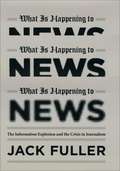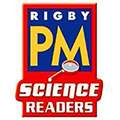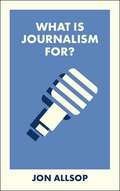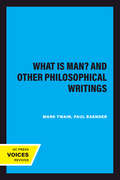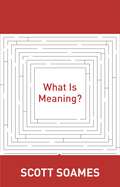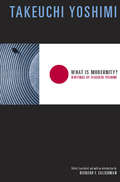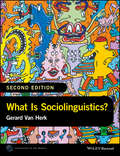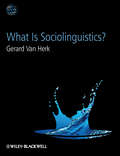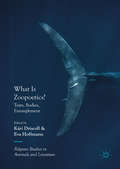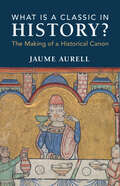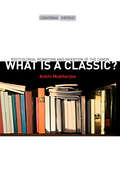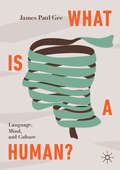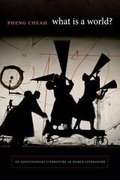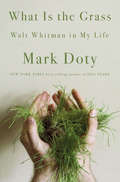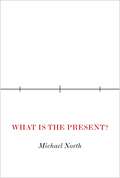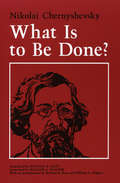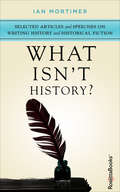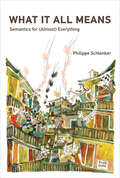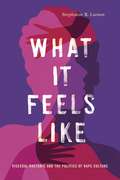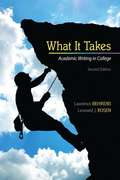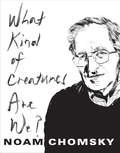- Table View
- List View
What Is Happening to News: The Information Explosion and the Crisis in Journalism
by Jack Fuller<P>Across America, newspapers that have defined their cities for over a century are rapidly failing, their circulations plummeting even as opinion-soaked Web outlets like the Huffington Post thrive. Meanwhile, nightly news programs shock viewers with stories of horrific crime and celebrity scandal, while the smug sarcasm and shouting of pundits like Glenn Beck and Keith Olbermann dominate cable television. <P> Is it any wonder that young people are turning away from the news entirely, trusting comedians like Jon Stewart as their primary source of information on current events? In the face of all the problems plaguing serious news, What Is Happening to News explores the crucial question of how journalism lost its way--and who is responsible for the ragged retreat from its great traditions. <P>Veteran editor and newspaperman Jack Fuller locates the surprising sources of change where no one has thought to look before: in the collision between a revolutionary new information age and a human brain that is still wired for the threats faced by our prehistoric ancestors. <P>Drawing on the dramatic recent discoveries of neuroscience, Fuller explains why the information overload of contemporary life makes us dramatically more receptive to sensational news, while rendering the staid, objective voice of standard journalism ineffective. <P>Throw in a growing distrust of experts and authority, ably capitalized on by blogs and other interactive media, and the result is a toxic mix that threatens to prove fatal to journalism as we know it. <P>For every reader troubled by what has become of news--and worried about what the future may hold--What Is Happening to News not only offers unprecedented insight into the causes of change but also clear guidance, strongly rooted in the precepts of ethical journalism, on how journalists can adapt to this new environment while still providing the information necessary to a functioning democracy.
What Is History For?: Johann Gustav Droysen and the Functions of Historiography
by Arthur Alfaix AssisA scholar of Hellenistic and Prussian history, Droysen developed a historical theory that at the time was unprecedented in range and depth, and which remains to the present day a valuable key for understanding history as both an idea and a professional practice. Arthur Alfaix Assis interprets Droysen's theoretical project as an attempt to redefine the function of historiography within the context of a rising criticism of exemplar theories of history, and focuses on Droysen's claim that the goal underlying historical writing and reading should be the development of the subjective capacity to think historically. In addition, Assis examines the connections and disconnections between Droysen's theory of historical thinking, his practice of historical thought, and his political activism. Ultimately, Assis not only shows how Droysen helped reinvent the relationship between historical knowledge and human agency, but also traces some of the contradictions and limitations inherent to that project.
What Is It Made Of? (Rigby PM Shared Readers #Levels 3-5)
by Julie HaydonA boy and his father go to a park and use the play equipment.
What Is Journalism For? (What Is It For?)
by Jon AllsopWhat is at stake when journalism is threatened? Does society still need journalists? Journalism faces multiple threats today all over the world: economic decline, online disinformation, the rise of AI, authoritarian curbs on freedom of the press, and violence against journalists. In such a climate, it’s more urgent than ever to ask what journalism is for. Drawing on his experience as a journalist and media commentator, and on interviews with journalists from the US to Myanmar, Jon Allsop examines key concepts that constitute journalism’s role: good judgement, concern for truth and critical scrutiny of one or more communities. Along the way, he also considers the relationship between journalism and activism; whether journalists should aspire to change the world and whether they can be seen as champions of democracy.
What Is Man? and Other Philosophical Writings (The Works of Mark Twain #19)
by Mark TwainThe volume includes Mark Twain's previously published philosophical writing. Fictional pieces (even some which develop arguments contained here) are ordinarily excluded, as are other works appropriate to different volumes in this edition. However, "Letter from the Recording Angel," "The Five Boons of Life," and "Letters from the Earth," although they are in a strict sense fictional, have been judged more relevant to the present volume that to the volumes of short fiction. "Things a Scotsman Wants to Know," previously unpublished, is included by agreement with the editor of The Mark Twain Papers, as being especially relevant to themes of this volume. Other unpublished items appear as supplements because of their close relation to What Is Man?, Christian Science, and " 'The Turning Point of My Life.' " The two works that break off with unfinished sentences, "Bible Teaching and Religious Practice" and the introductory section of "Letters from the Earth," were abandoned by the author or else their endings have been lost. The order of works in this volume is according to date of publication or, for those unpublished during the author's lifetime, date of composition. For works published during his lifetime, dates of first publication appear in roman type below titles; for works first published after his death, date are in italics and indicate time of composition.
What Is Meaning? (Soochow University Lectures in Philosophy #4)
by Scott SoamesThe tradition descending from Frege and Russell has typically treated theories of meaning either as theories of meanings (propositions expressed), or as theories of truth conditions. However, propositions of the classical sort don't exist, and truth conditions can't provide all the information required by a theory of meaning. In this book, one of the world's leading philosophers of language offers a way out of this dilemma. Traditionally conceived, propositions are denizens of a "third realm" beyond mind and matter, "grasped" by mysterious Platonic intuition. As conceived here, they are cognitive-event types in which agents predicate properties and relations of things--in using language, in perception, and in nonlinguistic thought. Because of this, one's acquaintance with, and knowledge of, propositions is acquaintance with, and knowledge of, events of one's cognitive life. This view also solves the problem of "the unity of the proposition" by explaining how propositions can be genuinely representational, and therefore bearers of truth. The problem, in the traditional conception, is that sentences, utterances, and mental states are representational because of the relations they bear to inherently representational Platonic complexes of universals and particulars. Since we have no way of understanding how such structures can be representational, independent of interpretations placed on them by agents, the problem is unsolvable when so conceived. However, when propositions are taken to be cognitive-event types, the order of explanation is reversed and a natural solution emerges. Propositions are representational because they are constitutively related to inherently representational cognitive acts. Strikingly original, What Is Meaning? is a major advance.
What Is Modernity?: Writings of Takeuchi Yoshimi (Weatherhead Books on Asia)
by Yoshimi TakeuchiRegarded as one of the foremost thinkers in postwar Japan, Takeuchi Yoshimi (1910-1977) questioned traditional Japanese thought and radically reconfigured an understanding of the subject's relationship to the world. His works were also central in drawing Japanese attention to the problems inherent in western colonialism and to the cultural importance of Asia, especially China. Takeuchi's writings synthesized philosophy, literature, and history, focusing not simply on Japan and the West but rather on the triangular relationship between Japan, the West, and China. This book, which represents the first appearance of Takeuchi's essays in English translation, explores Japanese modernity, literature, and nationalism as well as Chinese intellectual history.Takeuchi's research demonstrates how Asians attempted to make sense of European modernity without sacrificing their own cultural histories. An authentic method of modernity for Asia, Takeuchi concludes, needs to stress difference and plurality as opposed to the homogenizing force of westernization.
What Is Sociolinguistics?
by Gerard Van HerkHow is our language affected by our ethnicity, gender, and region? How are our conversations and other interactions structured? How does society view and regulate language? How do we use language to present ourselves to others? In this revised and updated second edition of the popular What Is Sociolinguistics? Gerard Van Herk explores these and other intriguing questions about language, how we use it, and its relationships to society. Van Herk guides the reader on a tour through the major issues that define the field, including region, status, gender, time, language attitudes, interaction, and style, at the same time exploring the sociolinguistics of multilingualism, culture and ethnicity, language contact, and education. This second edition has been revised and updated to include new and more exercises, discussion questions, and suggested readings, as well as expanded chapters exploring gender duality and Latino English. Key readings are introduced in Van Herk’s clear and engaging voice, which accompanies the text throughout, providing an accessible point of entry for those new to, or less familiar with, sociolinguistics. Chapter summaries and textboxes are similarly employed to signpost and illuminate learning. A companion website features PowerPoint slides for each chapter with suggestions for framing class discussions and exercises, further examples of concepts discussed, additional reading suggestions, and ready-to-go slides for class presentation. Packed with the latest research and practical teaching aids, What is Sociolinguistics? Second edition retains the highly-praised character of its predecessor and provides an essential up-to-date text for both students and instructors alike.
What Is Sociolinguistics? (Linguistics in the World #10)
by Gerard Van HerkWhat is Sociolinguistics? is a tour through the major issues that define the field, such as region, status, gender, time, language attitudes, interaction, and style, while also exploring the sociolinguistics of multilingualism, culture and ethnicity, language contact, and education, all introduced with excitement, humor, and deep knowledge. Explores the sociolinguistics of multilingualism, culture and ethnicity, language contact, and education Provides useful and clear learning features including numerous innovative exercises and project ideas, spotlighted research readings, glossary terms, chapter summaries, and text boxes The Companion Website for Instructors (www.wiley.com/go/vanherkprofs) has PowerPoint slides for each chapter with suggestions for framing class discussions and exercises, further examples on concepts discussed in the book, tips on additional readings to bring in, and ready-to-go slides for class presentation. The Companion Website for Students (www.wiley.com/go/vanherk) includes links for every chapter from standard sociolinguistic tools to links designed to spark discussion relevant to each chapter, including video clips, oral histories, articles, and more.
What Is Zoopoetics?
by Kári Driscoll Eva HoffmannThis book brings together essays dealing with the question of zoopoetics both as an object of study—i.e. texts from various traditions and periods that reflect, explicitly or implicitly, on the relationship between animality, language and representation—and as a methodological problem for animal studies, and, indeed, for literary studies more generally. What can literary animal studies tell us about literature that conventional literary studies might be blind to? How can literary studies resist the tendency to press animals into symbolic service as metaphors and allegories for the human whilst also avoiding a naïve literalism with respect to the literary animal? The volume is divided into three sections: “Texts,” which focuses on the linguistic and metaphorical dimensions of zoopoetics; “Bodies,” which is primarily concerned with mimesis and questions of embodiment, performance, and lived experience; and “Entanglement,” which focuses on interspecies encounters and the complex interplay between word and world that emerges from them. The volume will appeal to scholars and students in the fields of animal studies, area studies and comparative literature, gender studies, environmental humanities, ecocriticism, and the broader field of posthumanism.
What Is a Classic in History?: The Making of a Historical Canon
by Jaume AurellWhat is a classic in historical writing? How do we explain the continued interest in certain historical texts, even when their accounts and interpretations of particular periods have been displaced or revised by newer generations of historians? How do these texts help to maintain the historiographical canon? Jaume Aurell's innovative study ranges from the heroic writings of ancient Greek historians such as Herodotus to the twentieth century microhistories of Carlo Ginzburg. The book explores how certain texts have been able to stand the test of time, gain their status as historiographical classics, and capture the imaginations of readers across generations. Investigating the processes of permanence and change in both historiography and history, Aurell further examines the creation of historical genres and canons. Taking influence from methodologies including sociology, literary criticism, theology, and postcolonial studies, What Is a Classic in History? encourages readers to re-evaluate their ideas of history and historiography alike.
What Is a Classic? Postcolonial Rewriting and Invention of the Canon
by Ankhi MukherjeeWhat Is a Classic? revisits the famous question posed by critics from Sainte-Beuve and T. S. Eliot to J. M. Coetzee to ask how classics emanate from postcolonial histories and societies. Exploring definitive trends in twentieth- and twenty-first century English and Anglophone literature, Mukherjee demonstrates the relevance of the question of the classic for the global politics of identifying and perpetuating so-called core texts. Emergent canons are scrutinized in the context of the wider cultural phenomena of book prizes, the translation and distribution of world literatures, and multimedia adaptations of world classics. Throughout, Mukherjee attunes traditional literary critical concerns to the value contestations mobilizing postcolonial and world literature. The breadth of debates and topics she addresses, as well as the book's ambitious historical schema, which includes South Asia, Africa, the Middle East, the West Indies, Australia, New Zealand, Europe, and North America, set this study apart from related titles on the bookshelf today.
What Is a Human?: Language, Mind, and Culture
by James Paul GeeIn a sweeping synthesis of new research in a number of different disciplines, this book argues that we humans are not who we think we are. As he explores the interconnections between cutting-edge work in bioanthropology, evolutionary biology, neuroscience, human language and learning, and beyond, James Paul Gee advances, also, a personal philosophy of language, learning, and culture, informed by his decades of work across linguistics and the social sciences. Gee argues that our schools, institutions, legal systems, and societies are designed for creatures that do not exist, thus resulting in multiple, interacting crises, such as climate change, failing institutions, and the rise of nationalist nationalism. As Gee constructs an understanding of the human that takes into account our social, collective, and historical nature, as established by recent research, he inspires readers to reflect for themselves on the very question of who we are—a key consideration for anyone interested in society, government, schools, health, activism, culture and diversity, or even just survival.
What Is a World?: On Postcolonial Literature as World Literature
by Pheng CheahIn What Is a World? Pheng Cheah, a leading theorist of cosmopolitanism, offers the first critical consideration of world literature's cosmopolitan vocation. Addressing the failure of recent theories of world literature to inquire about the meaning of world, Cheah articulates a normative theory of literature's world-making power by creatively synthesizing four philosophical accounts of the world as a temporal process: idealism, Marxist materialism, phenomenology, and deconstruction. Literature opens worlds, he provocatively suggests, because it is a force of receptivity. Cheah compellingly argues for postcolonial literature's exemplarity as world literature through readings of narrative fiction by Michelle Cliff, Amitav Ghosh, Nuruddin Farah, Ninotchka Rosca, and Timothy Mo that show how these texts open up new possibilities for remaking the world by negotiating with the inhuman force that gives time and deploying alternative temporalities to resist capitalist globalization.
What Is the Grass: Walt Whitman In My Life
by Mark DotyNamed a Most Anticipated Book of 2020 by Buzzfeed, Library Journal, The Millions, and The Rumpus Effortlessly blending biography, criticism, and memoir, National Book Award–winning poet and best-selling memoirist Mark Doty explores his personal quest for Walt Whitman. Mark Doty has always felt haunted by Walt Whitman’s bold, perennially new American voice, and by his equally radical claims about body and soul and what it means to be a self. In What Is the Grass, Doty—a poet, a New Yorker, and an American—keeps company with Whitman and his Leaves of Grass, tracing the resonances between his own experience and the legendary poet’s life and work. What is it then between us? Whitman asks. In search of an answer, Doty explores spaces—both external and internal—where he finds the poet’s ghost. He meditates on desire, love, and the mysterious wellsprings of the poet’s enduring work: a radical experience of transformation and enlightenment, queer sexuality, and an obsession with death, as well as unabashed love for a great city and for the fresh, rowdy character of American speech. In riveting close readings threaded with personal memoir and illuminated by awe, Doty reveals the power of Whitman’s persistent presence in his life and in the American imagination at large. How does a voice survive death? What Is the Grass is a conversation across time and space, a study of the astonishment one poet finds in the accomplishment of another, and an attempt to grasp Whitman’s deeply hopeful vision of human possibility.
What Is the Present?: A History of the Here and Now
by Michael NorthA provocative new look at concepts of the present, their connection to ideas about time, and their effect on literature, art, and cultureThe problem of the present—what it is and what it means—is one that has vexed generations of thinkers and artists. Because modernity places so much value on the present, many critics argue that people today spend far too much time in the here and now—but how can we tell without first knowing what the here and now actually is? What Is the Present? takes a provocative new look at this moment in time that remains a mystery even though it is always with us.Michael North tackles puzzles that have preoccupied philosophy, neuroscience, psychology, history, and aesthetic theory and examines the complex role of the present in painting, fiction, and film. He engages with a range of thinkers, from Aristotle and Augustine to William James and Henri Bergson. He draws illuminating examples from artists such as Fra Angelico and Richard McGuire, filmmakers like D. W. Griffith and Christopher Nolan, and novelists such as Elizabeth Bowen and Willa Cather. North offers a critical analysis of previous models of the present, from the experiential present to the historical period we call the contemporary. He argues that the present is not a cosmological or experiential fact but a metaphor, a figurative relationship with the whole of time. Presenting an entirely new conception of the temporal mystery Georg Lukács called the "unexplained instant," What Is the Present? explores how the arts have traditionally represented the present—and also how artists have offered radical alternatives to that tradition.
What Is to Be Done?
by Michael R. Katz Nikolai Chernyshevsky William G. Wagner"No work in modern literature, with the possible exception of Uncle Tom's Cabin, can compete with What Is to Be Done? in its effect on human lives and its power to make history. For Chernyshevsky's novel, far more than Marx's Capital, supplied the emotional dynamic that eventually went to make the Russian Revolution."--Joseph Frank, The Southern ReviewAlmost from the moment of its publication in 1863, Nikolai Chernyshevsky's novel, What Is to Be Done?, had a profound impact on the course of Russian literature and politics. The idealized image it offered of dedicated and self-sacrificing intellectuals transforming society by means of scientific knowledge served as a model of inspiration for Russia's revolutionary intelligentsia. On the one hand, the novel's condemnation of moderate reform helped to bring about the irrevocable break between radical intellectuals and liberal reformers; on the other, Chernyshevsky's socialist vision polarized conservatives' opposition to institutional reform. Lenin himself called Chernyshevsky "the greatest and most talented representative of socialism before Marx"; and the controversy surrounding What Is to Be Done? exacerbated the conflicts that eventually led to the Russian Revolution.Michael R. Katz's readable and compelling translation is now the definitive unabridged English-language version, brilliantly capturing the extraordinary qualities of the original. William G. Wagner has provided full annotations to Chernyshevsky's allusions and references and to the, sources of his ideas, and has appended a critical bibliography. An introduction by Katz and Wagner places the novel in the context of nineteenth-century Russian social, political, and intellectual history and literature, and explores its importance for several generations of Russian radicals.
What Isn't History?: Selected Articles and Speeches on Writing History and Historical Fiction
by Ian MortimerAn award-winning historian&’s guide to writing about history, in both fiction and nonfiction. Is history absolute? Is writing about the past an exact science, or is it more of a nebulous discipline open to different interpretations and points of view? These are important questions that noted historian Ian Mortimer says all serious writers of history must reflect on. This new collection explores those ideas, providing an analysis on how the immensity of chronicling the past lends itself to a wide variety of audiences and contexts. Mortimer teaches that the purpose of history goes beyond simply relaying events of yesterday—it is about finding the meaning and conveying it to living and future generations. It is up to the audience to determine what history means to them, and it is up to the historian—or historical fiction writer—to determine what is and what isn&’t history. What Isn&’t History? collects together for the first time the selected articles and speeches on writing history and historical fiction from Ian Mortimer, the bestselling author of Edward III: The Perfect King, The Time Traveler&’s Guide to Elizabethan England, and other popular titles, acclaimed as &“the most remarkable medieval historian of our time&” (The Times, London).
What It All Means: Semantics for (Almost) Everything
by Philippe SchlenkerHow meaning works—from monkey calls to human language, from spoken language to sign language, from gestures to music—and how meaning is connected to truth.We communicate through language, connecting what we mean to the words we say. But humans convey meaning in other ways as well, with facial expressions, hand gestures, and other methods. Animals, too, can get their meanings across without words. In What It All Means, linguist Philippe Schlenker explains how meaning works, from monkey calls to human language, from spoken language to sign language, from gestures to music. He shows that these extraordinarily diverse types of meaning can be studied and compared within a unified approach—one in which the notion of truth plays a central role. &“It&’s just semantics&” is often said dismissively. But Schlenker shows that semantics—the study of meaning—is an unsung success of modern linguistics, a way to investigate some of the deepest questions about human nature using tools from the empirical and formal sciences. Drawing on fifty years of research in formal semantics, Schlenker traces how meaning comes to life. After investigating meaning in primate communication, he explores how human meanings are built, using in some cases sign languages as a guide to the workings of our inner &“logic machine.&” Schlenker explores how these meanings can be enriched by iconicity in sign language and by gestures in spoken language, and then turns to more abstract forms of iconicity to understand the meaning of music. He concludes by examining paradoxes, which—being neither true nor false—test the very limits of meaning.
What It Feels Like: Visceral Rhetoric and the Politics of Rape Culture (Rhetoric and Democratic Deliberation #27)
by Stephanie R. LarsonWhat It Feels Like interrogates an underexamined reason for our failure to abolish rape in the United States: the way we communicate about it. Using affective and feminist materialist approaches to rhetorical criticism, Stephanie Larson examines how discourses about rape and sexual assault rely on strategies of containment, denying the felt experiences of victims and ultimately stalling broader claims for justice.Investigating anti-pornography debates from the 1980s, Violence Against Women Act advocacy materials, sexual assault forensic kits, public performances, and the #MeToo movement, Larson reveals how our language privileges male perspectives and, more deeply, how it is shaped by systems of power—patriarchy, white supremacy, and heteronormativity as well as masculine commitments to "science" or "evidence." In addition, Larson finds that the culture holds a general mistrust of testimony by women, stereotyping it as "emotional." But she also gives us hope for change, arguing that women’s testimony—the bodily, material expression of violation—is needed to give voice to victims of sexual violence and to present, accurately, the facts of these crimes. Larson makes a case for visceral rhetorics, theorizing them as powerful forms of communication and persuasion.Demonstrating the communicative power of bodily feeling, Larson challenges the long-held commitment to detached, distant, rationalized discourses of sexual harassment and rape. Timely and poignant, the book offers a much-needed corrective to our legal and political discourses.
What It Feels Like: Visceral Rhetoric and the Politics of Rape Culture (Rhetoric and Democratic Deliberation)
by Stephanie R. LarsonWinner of the 2022 Association for the Rhetoric of Science, Technology, and Medicine (ARSTM) Book AwardWinner of the 2022 Winifred Bryan Horner Outstanding Book Award from the Coalition of Feminist Scholars in the History of Rhetoric and CompositionWhat It Feels Like interrogates an underexamined reason for our failure to abolish rape in the United States: the way we communicate about it. Using affective and feminist materialist approaches to rhetorical criticism, Stephanie Larson examines how discourses about rape and sexual assault rely on strategies of containment, denying the felt experiences of victims and ultimately stalling broader claims for justice.Investigating anti-pornography debates from the 1980s, Violence Against Women Act advocacy materials, sexual assault forensic kits, public performances, and the #MeToo movement, Larson reveals how our language privileges male perspectives and, more deeply, how it is shaped by systems of power—patriarchy, white supremacy, ableism, and heteronormativity. Interrogating how these systems work to propagate masculine commitments to “science” and “hard evidence,” Larson finds that US culture holds a general mistrust of testimony by women, stereotyping it as “emotional.” But she also gives us hope for change, arguing that testimonies grounded in the bodily, material expression of violation are necessary for giving voice to victims of sexual violence and presenting, accurately, the scale of these crimes. Larson makes a case for visceral rhetorics, theorizing them as powerful forms of communication and persuasion.Demonstrating the communicative power of bodily feeling, Larson challenges the long-held commitment to detached, distant, rationalized discourses of sexual harassment and rape. Timely and poignant, the book offers a much-needed corrective to our legal and political discourses.
What It Takes: Academic Writing in College
by Laurence Behrens Leonard J. RosenWhat It Takes: Academic Writing in College prepares the reader for the most common college writing assignments: the summary, the critique, the synthesis, and the analysis.
What Kind of Creatures Are We? (Columbia Themes in Philosophy)
by Noam ChomskyThe renowned philosopher and political theorist presents a summation of his influential work in this series of Columbia University lectures. A pioneer in the fields of modern linguistics and cognitive science, Noam Chomsky is also one of the most avidly read political theorist of our time. In this series of lectures, Chomsky presents more than half a century of philosophical reflection on all three of these areas. In precise yet accessible language, Chomsky elaborates on the scientific study of language, sketching how his own work has implications for the origins of language, the close relations that language bears to thought, its eventual biological basis. He expounds and criticizes many alternative theories, such as those that emphasize the social, the communicative, and the referential aspects of language. He also investigates the apparent scope and limits of human cognitive capacities. Moving from language and mind to society and politics, Chomsky concludes with a philosophical defense of a position he describes as "libertarian socialism," tracing its links to anarchism and the ideas of John Dewey, and even briefly to the ideas of Karl Marx and John Stuart Mill. Demonstrating its conceptual growth out of our historical past, he also shows its urgent relation to our present moment.
What Language Do I Dream In?: A Memoir
by Elena LappinTaking its title from a question often asked of polyglots, What Language Do I Dream In? is Elena Lappin's stunning memoir about how language runs throughout memory and family history to form identity. Lappin's life could be described as "five languages in search of an author", and as a multiple émigré, her decision to write in English was the result of many wanderings. Russian, Czech, German, Hebrew, and finally, English: each language is a link to a different piece of Lappin's rich family mosaic and the struggle to find a voice in a language not one's own.From Europe to North America—and back again, via some of the twentieth century's most significant political upheavals—Lappin reconstructs the stories and secrets of her parents and grandparents with the tenderness of a novelist and the eye of a documentary filmmaker. The story of Lappin's identity is unexpectedly complicated by the discovery, in middle age, that her biological father was an American living in Russia. This revelation makes her question the very bedrock of her knowledge of her birth, and adds a surprising twist: suddenly, English may be more than the accidental "home in exile"—it is a language she may have been close to from the very beginning."English is not my mother tongue," writes Elena Lappin, "it is something more valuable: a language I was lucky enough to be able to choose." What Language Do I Dream In? is a wonderful, honest story about love, family, memory, and how they intertwine to form who we are.
